People consider the GDPR as the new EU data protection legislation. Authorities established these regulations to safeguard personal data in the contemporary era of data processing, which affects organisations globally. This guide provides insight into the historical background, accurate concepts, and real-life application of GDPR and why it is relevant to current society.
History and Background
Authorities designed this regulation to address the demands that emerged with the Internet and ensure the security of personal information. Authorities adopted this regulation to replace the Data Protection Directive 95/46/EC, which technological advancements had made irrelevant.
The European Parliament formally passed the GDPR in April 2016, though enforcement started on May 25, 2018. The EU had critical responsibilities for its development; it sought to establish the standardisation of data protection acts throughout the countries it comprises while enhancing people’s privacy.
What Is GDPR And Why Is It So Important?
Since 2013, the EU has worked hard to update and modernise its old-fashioned data protection laws to bring those absolute and irrelevant laws into the twenty-first century.
The GDPR, which took effect in 2018, updated old rules such as the Data Protection Act 1998 to align with the purpose of the GDPR. It strengthens how personal data is protected, ensuring that businesses in the EU are transparent about handling your information and are accountable for keeping it safe. It also gives you more control over your data.
GDPR 2024 aims to stop data misuse and breaches by adapting to new technology and global data issues, ensuring EU citizens’ privacy and security.
What does GDPR do?
The GDPR establishes rules for how organisations should handle personal information, including specific processing conditions under the GDPR. It aims to protect your privacy by ensuring companies clearly explain how they use your data, take responsibility for keeping it safe, and give you control over how they use it.
What are two reasons to get the GDPR right?
Two reasons the EU introduced the GDPR:
-
- Ensure that organisations are more aware. The inherent dangers related to hacking and cybercrime that have emerged in recent years undoubtedly justify the aims of the GDPR.
-
- More control is what the European Union desires to facilitate organisations with increased clarity and uniformity and how they should act about personal data management and control.
Are you GDPR compliant?
General Information
-
- The European Parliament overwhelmingly supported the GDPR in May 2016.
-
- Applicable to all member states of the EU as of 25 May 2018.
-
- The GDPR imposes an automatic legal obligation on member states as a regulation, so they do not need to draw up new legislation.
Compliance Status
-
- Despite the immense hype and publicity, many organisations still have not complied.
-
- Non-compliance with GDPR can result in severe consequences and hefty fines.
-
- Many businesses still need to learn about GDPR and how to comply with it.
Awareness Statistics
-
- IDC’s survey found that 20% of small businesses in the UK and Germany did not know about GDPR just months before its enforcement date.
-
- Outside the EU, awareness numbers could be a lot higher.
Global Reach
-
- GDPR applies globally to companies that process data of EU citizens, regardless of their location.
-
- Authorities may impose penalties that reach € 20 million or 4 percent of the company’s annual worldwide business from the previous year.
-
- Authorities will surely fine Facebook and Google for not following the rules.
Recommended Actions
-
- Organisations must analyse the consequences of complying with GDPR.
-
- To avoid scrutinisation, organisations should begin with a GDPR audit to establish the current state of affairs and areas of risk.
-
- Organisations should implement the suggested strategies and follow good security practices to close these gaps and manage the risks.
Key Principles of GDPR
The GDPR principles and regulations outline fundamental rules to ensure data processing is conducted fairly and lawfully while protecting fundamental rights.
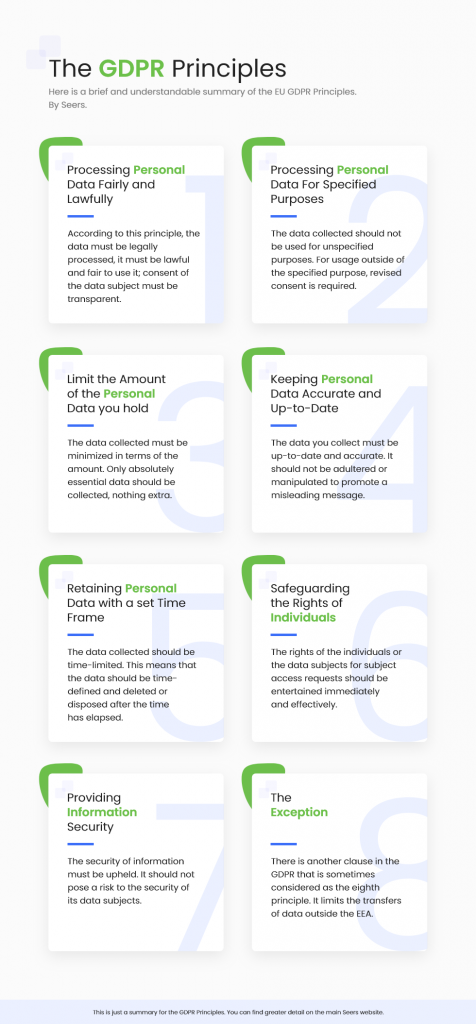
-
- Lawfulness, Fairness, and Transparency: Handle personal data legally, reasonably, and in a way that’s clear to people.
- Purpose Limitation: Only collect data for specific, legitimate reasons that are clearly stated.
- Data Minimisation: Gather only the data that is necessary for your purposes.
- Accuracy: Ensure personal data is correct and keep it updated.
- Storage Limitation: Keep data only as long as needed for its intended purpose.
- Integrity and Confidentiality (Security): Protect personal data with appropriate security measures.
- Accountability: Show that you comply with these data protection principles.
Scope and Applicability
GDPR aims for every organisation that handles personal information of EU citizens within the European Union’s territory, regardless of where the organisation operates. The regulation addresses a wide range of data, such as Personal Data and sensitive personal data. Pseudonymised data can still fall under the definition of personal data.
-
- Personal Data: any information that allows the identification of a person, including their personally identifiable information (PII), is considered personal data.
-
- Sensitive Data: Sensitive personal data covers data concerning a natural person’s race or ethnic origin, political opinions, religion or beliefs, health, and genetics.
Rights of Data Subjects
The GDPR grants individuals (data subjects) several rights to ensure protection of their data.
-
- Right to be Informed: Informed rights apply to how others collect and use personal data.
- Right of Access: They are empowered to gain the right to access personal data and be oriented on its processing.
- Right to Rectification: The client and any other relevant person can ask for changes if the data collected is wrong or missing.
- Right to Erasure (Right to be Forgotten): People can sometimes erase data from the Cloud.
- Right to Restrict Processing: You can ask a company to stop using your data for a while.
- Right to Data Portability: Citizens can obtain their data from service providers and reuse it across services of their choice.
- Right to Object: Individuals have the right to object to data processing on the grounds of legitimate interests or advertising, thereby protecting themselves.
- Rights related to Automated Decision-Making and Profiling: The data controller should not be immediately blamed when making automated individual decisions.
Summary of New GDPR Consumer Rights
The GDPR introduced several new rights for purchasers, enhancing their control over private records.
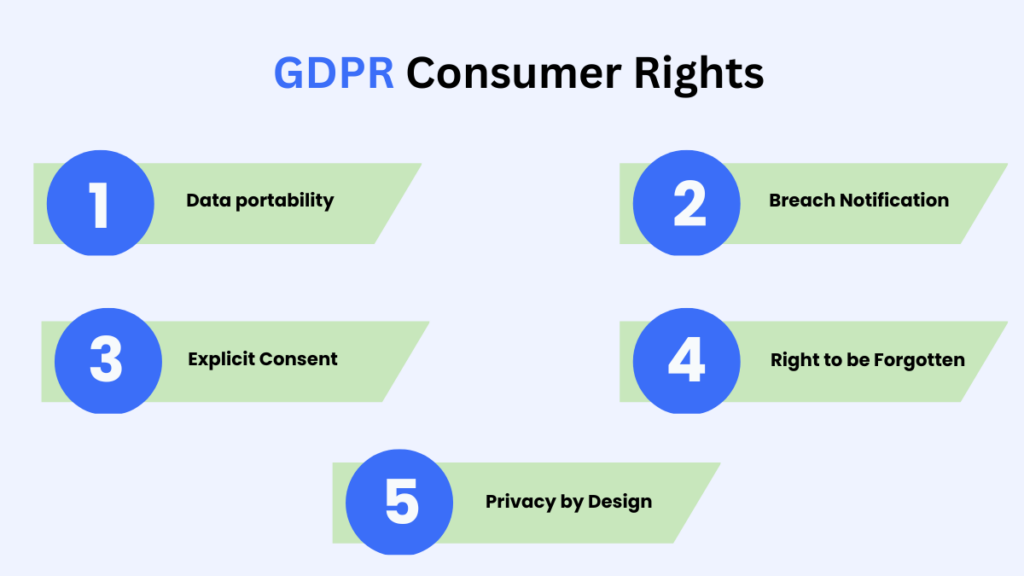
-
- Data portability allows clients to exchange data efficiently and quickly from one provider issuer to the next.
- Breach Notification: In a GDPR breach, you should notify clients within 72 hours that their data has been leaked to the general public.
- Explicit Consent: Corporations can only process consumers’ data after obtaining their prior consent, which means they need to acquire clear and precise consent from consumers.
- Right to be Forgotten: Citizens can demand that their data be removed; hence, everybody has the right to manage the digital profile created about them.
- Privacy by Design: Organisations must now design and implement data protection within different systems and procedures.
How Does GDPR Affect Businesses?
Within any organisation, designated data controllers and processors must adhere to and abide by the GDPR.
-
- Data controllers will understand GDPR and provide precise information about the processing of personal data within and outside their organisation.
-
- A data processor deals with the actual processing.
-
- A “controller” refers to any organisation. This can be a private business making profits, a charity, a non-governmental organisation, or a government organisation.
-
- A “processor” could be an outsourced or third-party company, such as an Information Technology (IT) organisation or a marketing service provider, that will carry out the data processing on behalf of the data controller.
The main difference GDPR introduces relates to how controllers and processors interact. Controllers maintain ultimate processing control over data, even if they outsource it.
Obligations for Organisations
Organisations must adhere to several obligations, including robust data governance practices, to ensure compliance with GDPR.
-
- Data Protection by Design and Default: Introducing the management and handling of data protection as part of business processes and systems.
-
- Maintaining Records of Processing Activities: Accounting for all the activities in processing data.
-
- Data Protection Impact Assessments (DPIAs): The first step in developing such a tool is to evaluate it on two levels: how the data is collected, processed, and exchanged on the one hand and how it is used on the other. Appoint Protection of Data Official (DPO)
-
- Appointing Data Protection Officers (DPOs): Companies appoint employees such as DPOs to present and implement the plan of action to the defence and compliance department management.
-
- We are ensuring Data Breach Notifications: The data controller must notify the regulatory authority of the data breach within 72 hours, and if necessary, inform the affected people.
-
- Obtaining Valid Consent: The two primary requisites for obtaining valid consent are that the data subject gives free consent for a specific reason and that the data subject has the necessary information to participate in the decision-making process from beginning to end.
What Is The Significance Of “Personal Data” Under The GDPR?
The General Data Protection Regulation (GDPR) defines personal data in many ways. There is a wide range, so individual organisations will need to closely examine the type of data collected. Besides, it includes common personal data such as names, addresses, email addresses, age, and date of birth. GDPR has some special categories of personal data, such as:
-
- IP address
-
- Economic
-
- Cultural
-
- Health information
-
- Political
-
- Criminal
-
- Biometric
-
- Religion
Data Breaches And What To Expect
The GDPR requires the data controller to inform the relevant data protection authorities. This has to be done within the first 72 hours. For your assignment, complete the objectives below.The point at which an organisation becomes aware of the loss or potential loss.
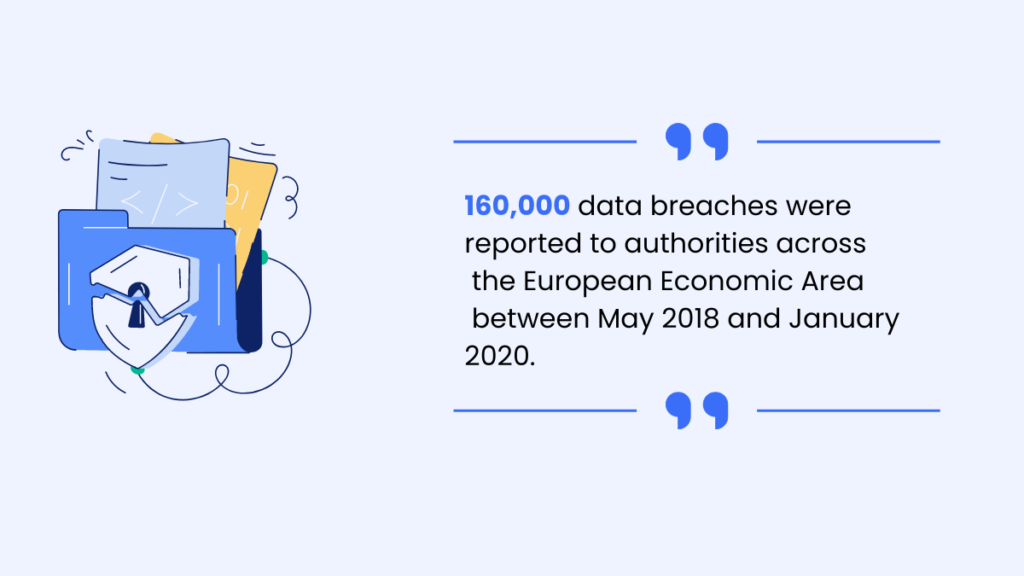
In the United Kingdom, the Information Commissioner’s Office holds the contact responsibility. Authorities urge organisations to put together a procedure list. It is to inform all personnel on how to act if a breach is suspected as follows:
-
- Firstly, the exact time, date and place of the breach
-
- Secondly, a detailed description of every aspect of data involved in the breach
-
- Thirdly, Organisations must document the list of systems affected.
-
- The department/branch/office and personnel involved in discovering or causing the breach.
-
- Lastly, Organisations should immediately correct or mitigate the impact of the suspected or actual breach.
Penalties and Enforcement
In the UK, GDPR Law imposes significant fines for non-compliance, using a tiered approach based on the severity of the violation.
-
- Lower Tier: A maximum of 10 million Euros or twice the companies’ annual turnover on a global level, whichever is the more significant amount.
-
- Upper Tier: Authorities may impose fines ranging from €20,000,000 to 4% of the total worldwide turnover of the group of companies.
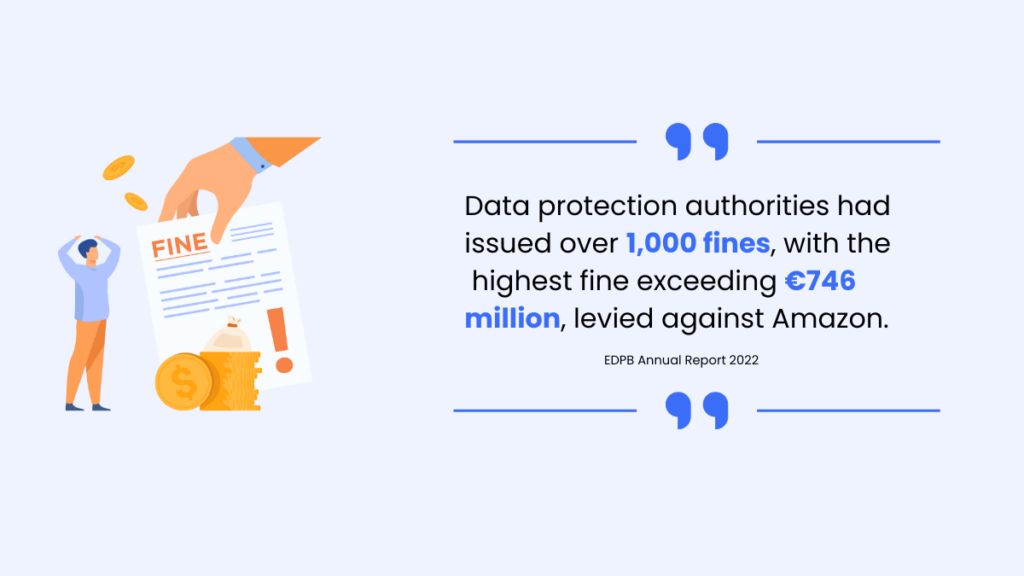
High-profile cases, like Google and British Airways, clearly show the monetary and image costs of GDPR noncompliance.
Compliance Strategies
Organisations should implement the following strategies to achieve GDPR compliance:
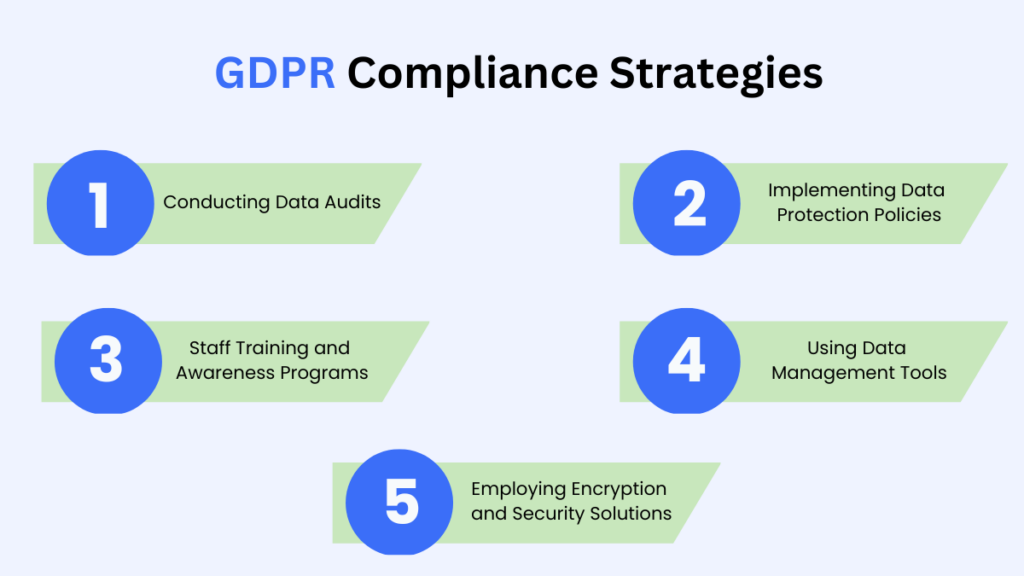
-
- Conducting Data Audits: Ensure information processing reconsideration is done quite often.
-
- Implementing Data Protection Policies: Organizations must establish coherent data protection policies at both procedural and strategic levels.
-
- Staff Training and Awareness Programs: Train the company’s human resources on the provisions of GDPR and the recommended measures to take.
-
- Using Data Management Tools: Use software tools to handle the data and make compliance.
-
- Employing Encryption and Security Solutions: Use advanced security features to secure data.
Challenges
Organisations face various challenges in achieving and maintaining GDPR compliance, including:
-
- International Data Transfers: The compliance measures that should be taken to transport data across the UE.
- Vendor and Third-Party Compliance: The monitoring and enforcing of GDPR requirements throughout the supply chains.
- Data Protection for Minors: Processing personal data of children and receiving informed consent from parents and legal guardians.
- Emerging Technologies: Privacy and AI, IoT, and big data analytics: current challenges and possible solutions.
- Data Breach Readiness: Adoption of measures to deal with the effects of acts of cyber-commercial espionage.
- Complex Organisational Structures: Can you maintain compliance with various groups or departments in the organisation and across different regions?
- Legal and Regulatory Updates: Updates on shifts in GDPR policies coupled with other enforcement actions.
The Future of GDPR
The GDPR has established a global benchmark for information safety, shaping policies along with the California Consumer Privacy Act (CCPA) and inspiring similar legal guidelines worldwide. As generations advance, we expect new statistics on privacy and safety tendencies to emerge. Organisations should vigilantly adapt to these modifications to meet evolving regulatory requirements and patron expectations.
Key trends
-
- Implementing stricter controls over automated decision-making
-
- Increasing transparency in data handling practices
-
- Enhancing protections for sensitive data
Adapting to these trends will be crucial for organisations to maintain compliance and foster trust in an increasingly data-driven world.
Conclusion
In conclusion, the GDPR is a big deal. It’s a strict set of rules to protect people’s personal information. Companies that handle data from EU citizens must carefully follow these rules or face hefty fines.
Seers can help! We provide the tools and expertise your business needs to stay GDPR compliant. From understanding the GDPR regulations to putting them into practice, we’re here to help every step of the way.
Seers Your Expert Partner in GDPR Compliance and Training
Seers Overview:
- Seers provides an advanced GDPR Audit Tool to ensure complete data privacy compliance.
- Our tool helps businesses meet GDPR regulations effectively and avoid hefty fines.
Founding Purpose:
- The Seers platform was created to empower businesses with the tools they need to excel in GDPR compliance.
Passion and Motivation:
- We are passionate about data privacy and ensuring businesses meet legal requirements seamlessly.
- Our mission is to provide reliable solutions that build trust and enhance brand reliability.
What We Offer:
- A comprehensive GDPR Audit Tool for thorough compliance checks.
- Customisable GDPR training programs to educate your team on data protection.
- Easy integration with your existing systems and processes.
- Ongoing support to navigate GDPR requirements seamlessly.
- Opportunities for strategic partnerships to enhance compliance efforts.
Ready to ensure GDPR compliance effortlessly with Seers?
Start Your Free Trial
